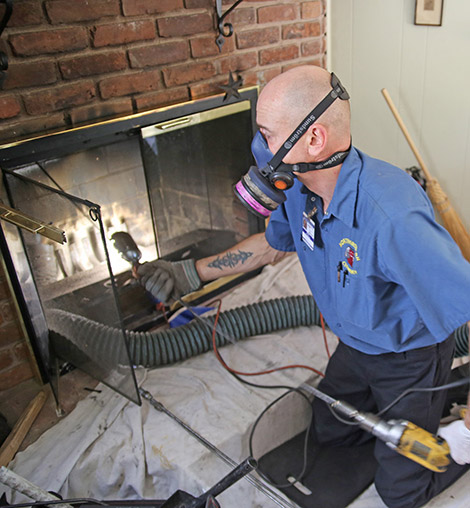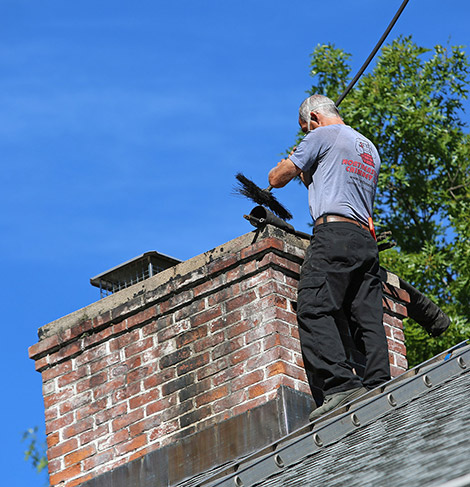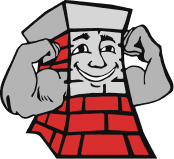Can a Dirty Chimney Make You Sick?
Dirt is often on our minds in spring and it’s partly for the purpose of cleaning to improve indoor air quality. A common question that arises is whether a dirty chimney can make you sick or is it safe to leave it as is? Good question because threats to your wellness do lurk in dirty chimneys every season of the year. Read on to learn some of the ways dirty chimneys make you sick and the symptoms associated with those illnesses.
Creosote
 What makes chimneys the dirtiest is creosote, a highly flammable, tar-like substance deposited in chimney flues with every wood fire. The toxic combustion materials created by wood fires don’t all go up and out of the chimney. Some amount is always left behind, and it is what’s called “creosote.” There are three primary dangers associated with creosote: Chimney fires, toxic poisoning, and various health issues associated with making direct contact and breathing in particles of the brownish-black gook.
What makes chimneys the dirtiest is creosote, a highly flammable, tar-like substance deposited in chimney flues with every wood fire. The toxic combustion materials created by wood fires don’t all go up and out of the chimney. Some amount is always left behind, and it is what’s called “creosote.” There are three primary dangers associated with creosote: Chimney fires, toxic poisoning, and various health issues associated with making direct contact and breathing in particles of the brownish-black gook.
Chimney Fires
A chimney fire is when the creosote or other material inside a chimney flue is ignited and burns inside the chimney. Thousands of house fires are started every year because of a dirty chimney filled with creosote. When the creosote is thick on the walls of a chimney liner, it continuously fuels a chimney fire. The heat often intensifies to the extent that the flue is destroyed, resulting in a life-threatening house fire.
Toxic Poisoning
Combustion gases from solid-fuel appliances are toxic, and it is very dangerous when they leak into the home. One of the gases is deadly carbon monoxide. A dirty chimney can cause you to breathe these dangerous fumes in the following ways:
- As a chimney fire is burning, a tremendous amount of combustion gases will usually billow back into the home, exposing occupants to carbon monoxide. Because it is odorless, tasteless, invisible, and symptomless, carbon monoxide is known as the “Silent Killer.” Because of this serious threat, it is vital to have a working carbon monoxide detector in the home when using gas and wood-fueled heating appliances.
- If your chimney liner has so many layers of creosote that the chimney becomes obstructed, toxic fumes flow back into the home instead of going outside. It’s important to realize that a smoky fireplace means you are exposed to these toxic gases.
 Once the symptoms of carbon monoxide poisoning begin having an effect, an exposed person may experience any or all of the following:
Once the symptoms of carbon monoxide poisoning begin having an effect, an exposed person may experience any or all of the following:
- Dizziness
- A dull headache
- Shortness of breath
- Weakness
- Blurred vision
- Confusion
- Nausea
- Vomiting
- Loss of consciousness
Carbon monoxide exposure results in death if a person doesn’t escape the fumes and get to some fresh air. People who survive sometimes experience debilitating health problems from carbon monoxide exposure.
Creosote Exposure
Your household is exposed to the creosote in your chimney when there isn’t a good seal created by the damper. If you were to try do-it-yourself chimney cleaning, which experts do not recommend, you would likely come into direct contact with creosote. Because you don’t have the same equipment professionals have, a DIY effort could result in excessive creosote in the air of your home. Exposure to creosote can cause the following health problems:
- Irritation to the respiratory system, including the potential for severe respiratory issues
- Inflammation of the mouth, nose, and throat
- Rashes, lesions, and other types of skin irritation
- Eye irritation
- Vision damage, if it gets directly in your eyes and you rub your eyes
- Abdominal discomfort
- Mental confusion
- Long-term exposure to creosote can cause kidney and liver problems, seizures, and skin cancer
Schedule chimney cleaning with the trusted experts at Northeastern Chimney, Inc. We are located in West Hartford, CT. If you want to help ensure the good health of your family by getting your dirty chimney cleaned, call us today at 860-233-5770.


